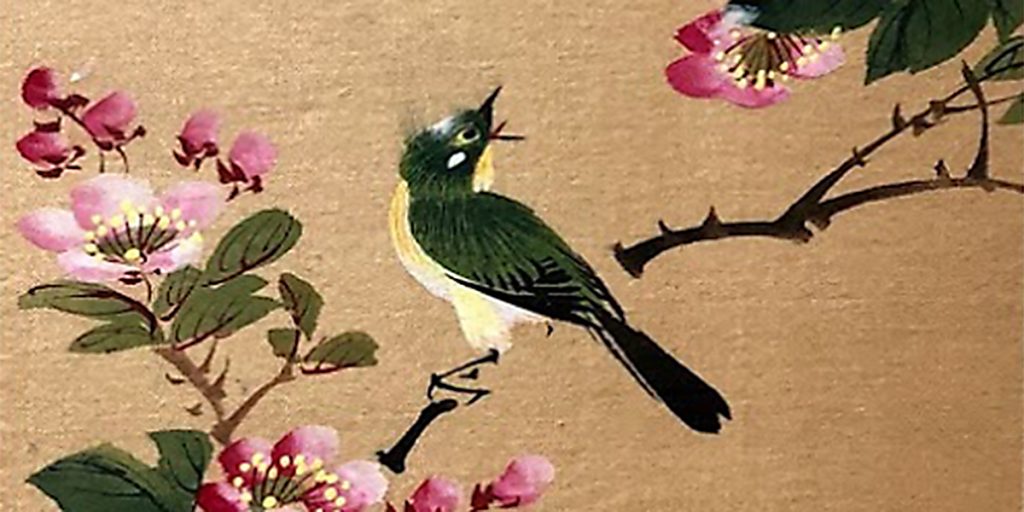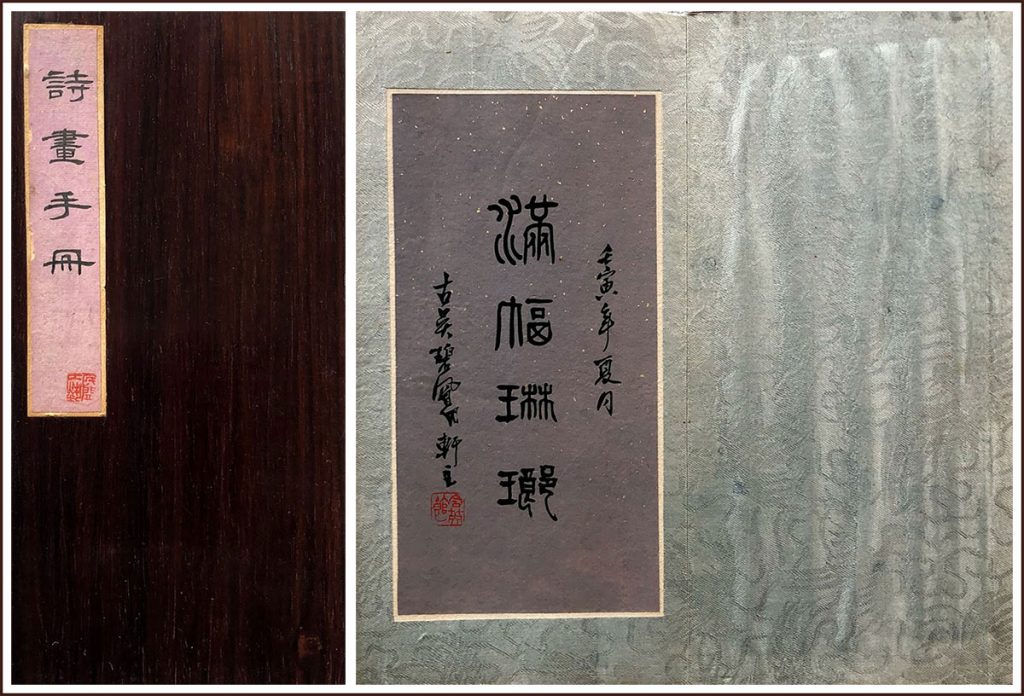The following transcription and translation of a 1960s Chinese Manual of Poetry and Painting in the museum’s study collection was created by Rebecca Li ’21 in connection with Professor Cynthia Packert’s spring 2020 course HARC 0347: Aesthetics of Asian Art.
Object Credit: Manual of Poetry and Painting, c. 1962. Study Collection of the Middlebury College Museum of Art. Gift of Barbara P. and Robert P. ’64 Youngman, SC 2009.01.
Brief Analysis
Partially legible inscriptions on the front endpaper of the Manual of Poetry and Painting dates it to the summer of a Ren Yin year (壬寅年夏⽉) in the Chinese 60-year calendar cycle. We can deduce based on this information and the booklet’s relatively fine condition that it was likely made in 1962, the closing phase of China’s three consecutive years of natural calamities that resulted in the death of 20 million people. Intentionally or not, the aesthetic message of the booklet avoids even the most remote correlation with the social circumstances of its contemporary reality: it truly is all about art.
The almost disorienting diversity of texts and images in the manual may already seem clear after a first reading. The calligraphy adopts styles of Zhuan, Li, Kai, and Xing, though it follows no chronological order, and fails to align with original time periods of the poetry. Largely consisted of landscapes and bird-and-flower paintings that stick to ordinary rules of color and composition, the artistic consistency of the booklet is broken by one exception: a portrait of a lady dressed with delicacy, whose slightly bowing posture and completely covered skin manifest deep yet subtle humility. This may, however, also be one of the few instances where the painting and poetry on the same spread correspond to each other directly and closely—right on the portrait’s left hand side is “Peony,” a work by Qing poet Gao Fenghan that could be seen as glorifying either the season of spring or a human being:
Seemingly awake yet somewhat dazed,
about to smile with a frown to be traced—
the type of beauty to make a city fall;
a bursting spring’s rain brings growth of grains.
When considering the manual as a whole, it remains intriguing why and how painting and poetry compose rather separate narratives. The very first image already lacks most key elements of “Dawn Scenery” by Yuan poet Huang Geng—“white birds,” “setting sun,” “rainbow,” and “thunderstorm”—which it accompanies. The metaphysical taste of “Yi”, a piece selected from the Classic of Poetry, and the excerpt from the “Epigraph of Zhang Heru of Wei,” also seem to fall short in the highly conventional visual imagery of animals, flowers, branches and leaves.
But an additional series of evidence point to the possibility that what is painted and what is written are meant to be interpreted independently, from each other and from history: the calligraphy is set not on the artworks but next to them, as a separate entity; neither the author and date nor any context of the original poetry is provided for reference; while the paintings could have been copies of established pieces, their sources of inspiration stay ultimately unknown. The little room we have to draw connections and formulate much of a larger picture leads us to focus on what actually gets put down on page. Observing the art as it is, we may see previously overlooked figures, highlights on flower pistils, and uniquely balanced shapes of negative space. Studying the poems by themselves, we notice common motifs such as water, mountains, the sky, the moon, and the sunset before making subjective interrogations of their representational significance.
詩畫⼿冊 | Manual of Poetry and Painting
滿幅琳瑯 | Brilliance Full and Wide
浮雲開合晚⾵輕
⽩⿃⾶還(邊)落照明
⼀曲彩虹橫界断
南⼭雷⾬北⼭晴
——[元] ⿈庚《暮景》/ ⾏
Floating clouds part and reunite, the evening breeze is light;
white birds fly at the edge of the sky, the setting sun is bright.
A rainbow broken halfway draws the line:
On mountains in the south, a thunderstorm strikes; on mountains in the north, the sun shines.
(Origin: “Dawn Scenery” by Huang Geng, Yuan dynasty. Script style: Xing.)
抑抑威儀
維德之隅
⼈亦有⾔
靡哲不愚
庶⼈之愚
亦職維疾
——[秦]《詩經·抑》節選 / 篆
One’s outlook shows dignity;
his character shows integrity.
There exists a saying:
Even a wise man can be foolish sometimes,
but a dull man’s foolishness
is an instinctive flaw to begin with.
(Origin: excerpt from “Yi” in the Classic of Poetry, Qin dynasty. Script style: Zhuan.)
最是桐窗夜⾬邊
舞⾐零落補寒煙
驅豪忽憶秋前夢
曾翦(剪)青羅覆⿅眠
——[清] 華嵒《⾃題寫⽣六⾸·蕉》/ ⾏
Night rain falls outside the window near a wutong tree;
dance dress scatters amidst the cold mist.
I moved the brush and suddenly recalled the dream before autumn
of cutting cyan fabric until sleeplessness.
(Origin: “Sketches from Life with Original Poetry – Jiao” by Hua Yan, Qing dynasty. Script style: Xing.)
稟陰陽之純精
含五⾏之秀氣
雅性⾼奇
識量冲遠
——[北魏]《魏張⿊⼥墓志》節選 / 隸
Receiving the purity of Yin and Yang
Containing the essence of the Five Elements
Elegance is a virtue noble and refined
Insight a knowledge ambitiously unique
(Origin: excerpt from “Epigraph of Zhang Heru of Wei,” Northern Wei dynasty. Script style: Li.)
常有好容顏
我欲觀其⼼(⼈)
晨去越河關
青松夾路⽣
——[晉] 陶淵明《擬古 其五》/ 隸
He whose face always fills with joy—
I intend to visit such soul,
setting off in the morning to cross rivers and obstacles.
Trails near where he lives are surrounded by pine trees.
(Origin: “In the Ancient Style – Five” by Tao Yuanming, Jin dynasty. Script style: Li.)
似醒還帶醉
欲笑却含顰
⼀種傾城⾊
⼗分穀⾬春
——[清] ⾼鳳翰《牡丹》
Seemingly awake yet somewhat dazed,
about to smile with a frown to be traced—
the type of beauty to make a city fall;
a bursting spring’s rain brings growth of grains.
(Origin: “Peony” by Gao Fenghan, Qing dynasty. Script style: Kai.)
偶隨芳草踏斜暉
⽯徑雲深翠滴⾐
兩袖天⾵明⽉上
杖頭挑得樹陰歸
——[元] 葉顒《晚步》/ 隸
Following the fragrant grass by accident into a sunset walk:
Stone trails deep into the clouds, leaves dressed in dewdrops.
Two sleeves of wind come from the sky, above the moon so bright;
top of the crutch picks up the shade of a tree, upon retreat.
(Origin: “Evening Stroll” by Ye Yong, Yuan dynasty. Script style: Li.)
秋景今宵半
天⾼⽉倍明
南樓誰宴賞
絲⽵奏清聲
——[宋] 汪洙《中秋》/ ⾏
Half of autumn has passed by tonight;
the sky is high and the moon especially bright.
Who is hosting a banquet at the pavilion in the south?
Stringed and wind instruments send a gentle tune.
(Origin: “Mid-Autumn” by Wang Zhu, Song dynasty. Script style: Xing.)
秋⽔⼀抹碧
晚霞幾縷紅
⽔窮雲盡處
隱隱兩三峯
——[唐] 張秦娥《遠⼭》/ 隸
Water in autumn resembles a green ribbon;
sunset glow is a few strands of red.
Where the water drains and clouds diminish,
two or three peaks faintly arise.
(Origin: “Distant Mountains” by Zhang Qin’e, Tang dynasty. Script style: Li.)
⾦池種碧蓮
蓮⼦誰當採
⾦粉不肯凋
豔⾊年年在
——[清] 惲壽平題款 / ⾏
Green lotuses are planted in a graceful pond—
who shall pick their seeds?
Gold powder would not fade—
its luster remains, year after year.
(Origin: inscription by artist Yun Shouping, Qing dynasty. Script style: Xing.)


![浮雲開合晚⾵輕 ⽩⿃⾶還(邊)落照明 ⼀曲彩虹橫界断 南⼭雷⾬北⼭晴 ——[元] ⿈庚《暮景》/ ⾏](https://sites.middlebury.edu/middartmuseum/files/2020/12/brilliance_full_and_wide_figure003-972x1024.jpg)
![抑抑威儀 維德之隅 ⼈亦有⾔ 靡哲不愚 庶⼈之愚 亦職維疾 ——[秦]《詩經·抑》節選 / 篆](https://sites.middlebury.edu/middartmuseum/files/2020/12/brilliance_full_and_wide_figure004-854x1024.jpg)
![最是桐窗夜⾬邊 舞⾐零落補寒煙 驅豪忽憶秋前夢 曾翦(剪)青羅覆⿅眠—— [清] 華嵒《⾃題寫⽣六⾸·蕉》/ ⾏](https://sites.middlebury.edu/middartmuseum/files/2020/12/brilliance_full_and_wide_figure005-803x1024.jpg)
![稟陰陽之純精 含五⾏之秀氣 雅性⾼奇 識量冲遠 ——[北魏]《魏張⿊⼥墓志》節選 / 隸](https://sites.middlebury.edu/middartmuseum/files/2020/12/brilliance_full_and_wide_figure006-912x1024.jpg)
![常有好容顏 我欲觀其⼼(⼈) 晨去越河關 青松夾路⽣ ——[晉] 陶淵明《擬古 其五》/ 隸](https://sites.middlebury.edu/middartmuseum/files/2020/12/brilliance_full_and_wide_figure007-966x1024.jpg)
![似醒還帶醉 欲笑却含顰 ⼀種傾城⾊ ⼗分穀⾬春 ——[清] ⾼鳳翰《牡丹》](https://sites.middlebury.edu/middartmuseum/files/2020/12/brilliance_full_and_wide_figure008-818x1024.jpg)
![偶隨芳草踏斜暉 ⽯徑雲深翠滴⾐ 兩袖天⾵明⽉上 杖頭挑得樹陰歸 ——[元] 葉顒《晚步》/ 隸](https://sites.middlebury.edu/middartmuseum/files/2020/12/brilliance_full_and_wide_figure009-867x1024.jpg)
![秋景今宵半 天⾼⽉倍明 南樓誰宴賞 絲⽵奏清聲 ——[宋] 汪洙《中秋》/ ⾏](https://sites.middlebury.edu/middartmuseum/files/2020/12/brilliance_full_and_wide_figure010-905x1024.jpg)
![秋⽔⼀抹碧 晚霞幾縷紅 ⽔窮雲盡處 隱隱兩三峯 ——[唐] 張秦娥《遠⼭》/ 隸](https://sites.middlebury.edu/middartmuseum/files/2020/12/brilliance_full_and_wide_figure011-940x1024.jpg)
![⾦池種碧蓮 蓮⼦誰當採 ⾦粉不肯凋 豔⾊年年在 ——[清] 惲壽平題款 / ⾏](https://sites.middlebury.edu/middartmuseum/files/2020/12/brilliance_full_and_wide_figure012-905x1024.jpg)
What is the provenance of this piece?
Annette, thanks for the inquiry. Realizing I hadn’t included a credit line, so I’ve edited the post to include: “Object Credit: Manual of Poetry and Painting, c. 1962. Study Collection of the Middlebury College Museum of Art. Gift of Barbara P. and Robert P. ’64 Youngman, SC 2009.01.”
This is so beautiful! Thank you for making these lovely paintings and poems accessible to a wide audience, Rebecca!